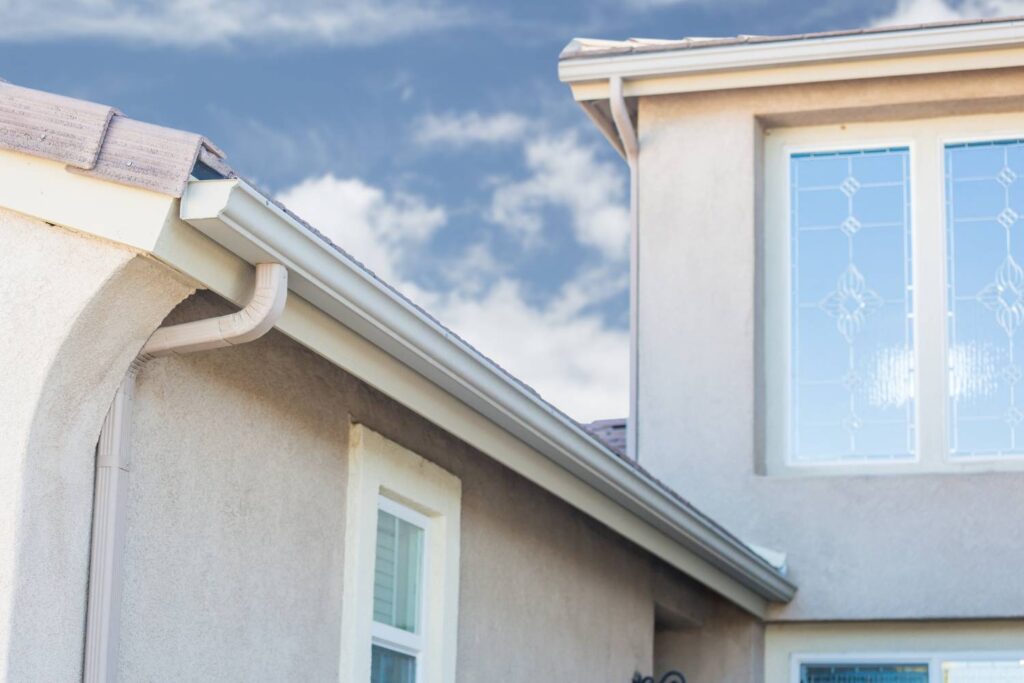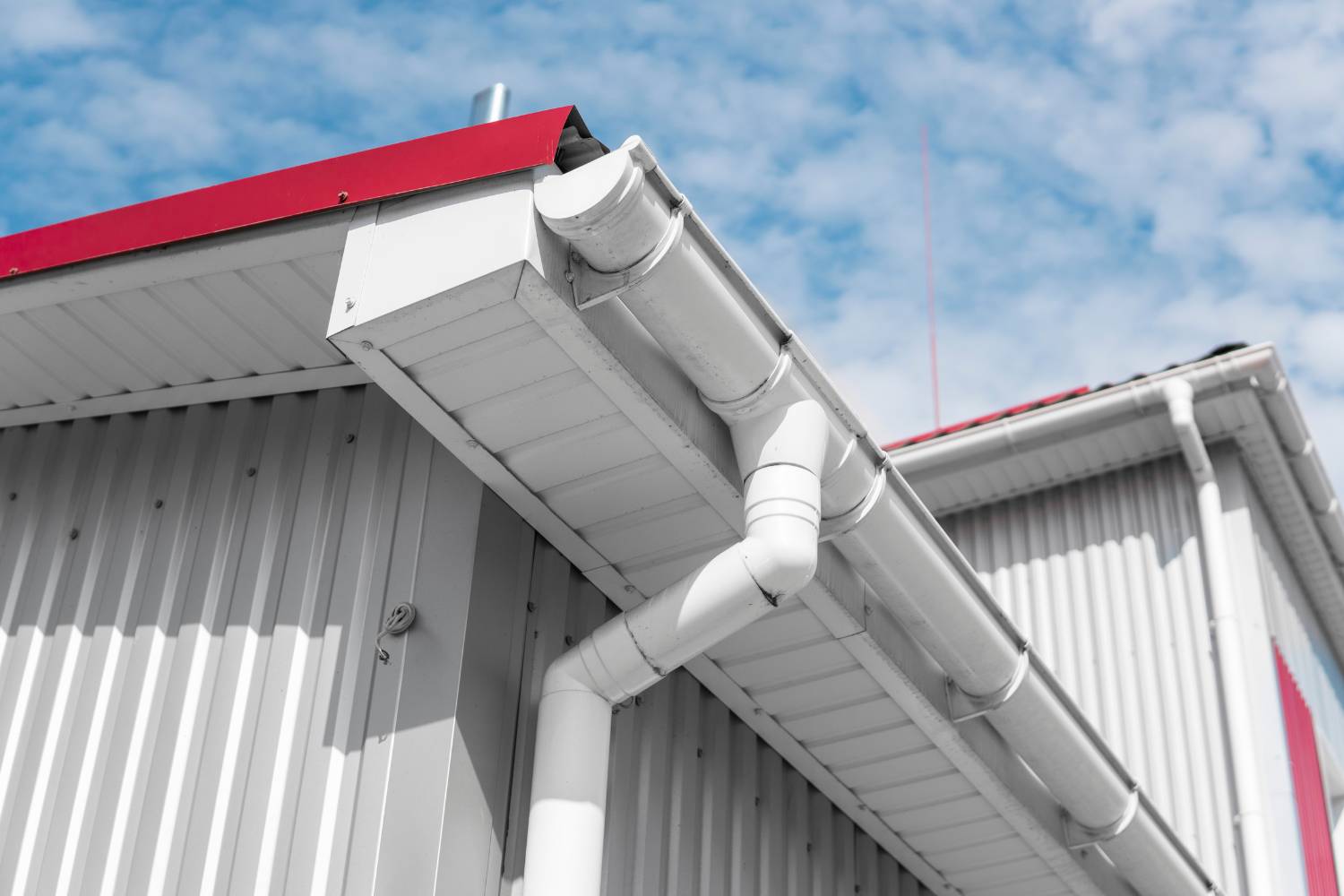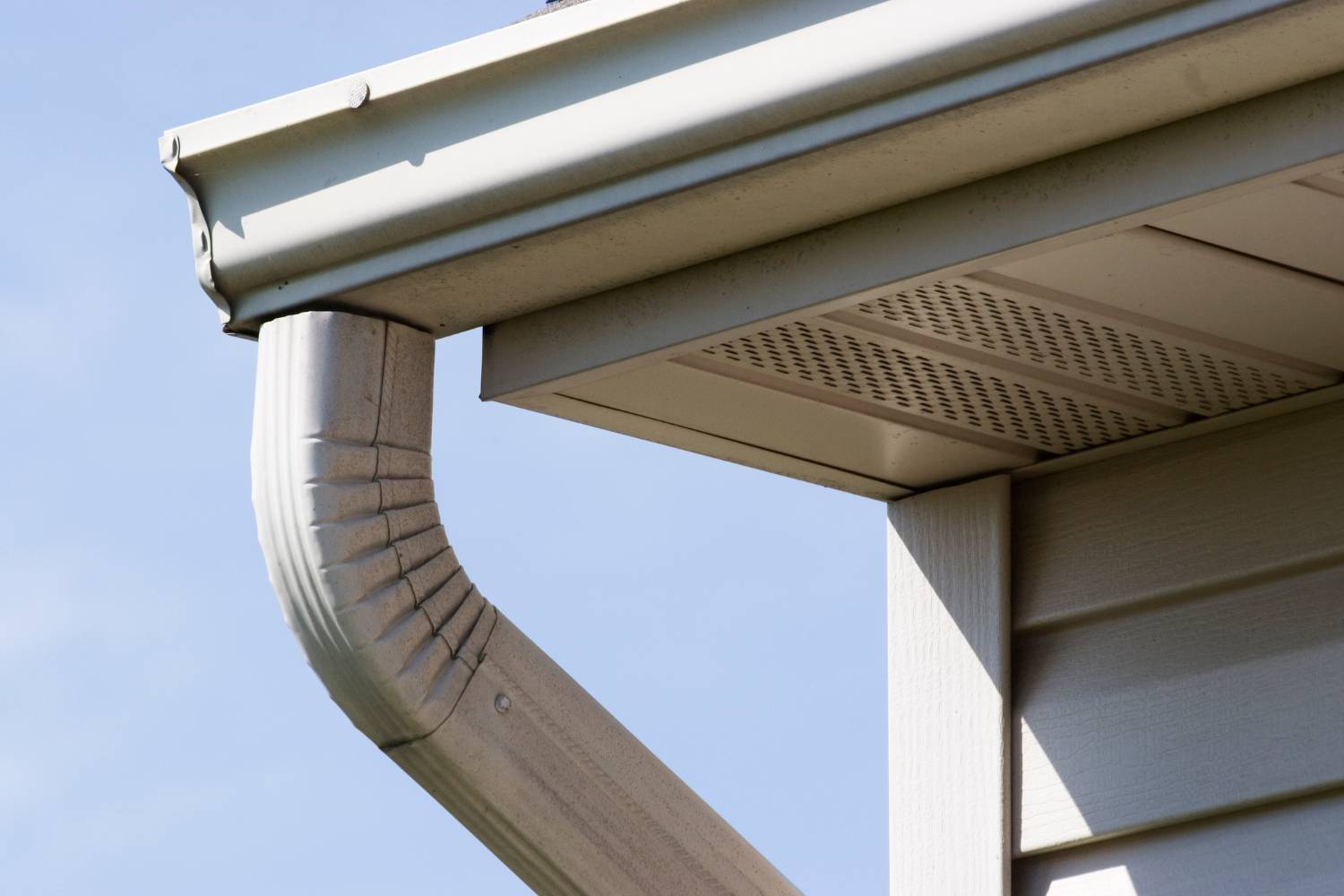Gutters are an essential component of your home's roofing system. They channel rainwater away from the foundation, preventing water damage and maintaining the structural integrity of your property. But how long does guttering typically last? This blog explores the various types of guttering materials, their advantages and disadvantages, and their expected lifespans to help you make an informed decision for your home.
Understanding the longevity of different gutter materials—from the cost-effective but less durable vinyl to the elegant and long-lasting copper—can help you choose the best option that balances cost, durability, maintenance, and aesthetic preferences.
We'll also delve into factors affecting the lifespan of gutters and offer tips on extending their longevity through regular maintenance and preventive measures. Whether you're installing new gutters or replacing existing ones, this guide will equip you with the knowledge to ensure your home remains protected from water damage for many years to come.
What Are the Types of Guttering Materials and Their Lifespan?
Choosing the right gutter material involves balancing factors like cost, durability, maintenance, and aesthetic preferences. While materials like copper and zinc offer exceptional longevity and unique looks, they come at a higher cost.
Aluminium and vinyl provide more affordable options but may require more frequent maintenance or replacement. Steel offers a strong middle ground with robust durability but potential rust issues. Understanding the pros, cons, and lifespans of these materials can help you select the best guttering solution for your home, ensuring protection and beauty for years to come.
Aluminium Gutters
Aluminium gutters are lightweight and easy to install, making them a popular choice among homeowners and professionals alike. They are rust-resistant, ensuring longevity and maintaining an attractive appearance over time. Additionally, aluminium gutters are cost-effective compared to other materials like copper or zinc.
However, they can dent from heavy impacts, such as falling branches or ladders leaning against them, and painted aluminium gutters can fade over time due to UV exposure, although they can be repainted. With proper maintenance, aluminium gutters can last between 20 to 30 years.
Copper Gutters
Copper gutters offer a unique, elegant look that develops a beautiful patina over time, adding character to any home. Copper is incredibly durable and resistant to corrosion, making it one of the longest-lasting gutter materials.
Additionally, copper gutters require minimal maintenance once installed. The main drawback is the high cost, both in terms of the material itself and the installation costs. Also, the natural patina that copper develops may not be desirable for all homeowners. Copper gutters can last over 50 years, with some lasting up to a century if properly maintained.
Steel Gutters
Steel gutters are very strong and can handle extreme weather conditions, including heavy snow and ice. Available in galvanised steel and stainless steel, they provide options based on budget and desired longevity. However, galvanised steel gutters can rust over time if not properly maintained, especially if the protective zinc coating wears off.
Additionally, steel gutters are heavier than aluminium and vinyl, requiring more robust support structures. Galvanised steel gutters typically last 20 to 30 years, while stainless steel gutters can last over 50 years.
Vinyl Gutters
Vinyl gutters are the most cost-effective option, making them a popular choice for budget-conscious homeowners. They are lightweight and easy to install, often suitable for DIY projects. Vinyl is immune to rust and corrosion. However, vinyl gutters are less durable than metal options and can become brittle and crack in extreme temperatures. Prolonged exposure to sunlight can cause vinyl gutters to fade or become discoloured. Vinyl gutters generally last around 10 to 20 years, depending on the climate and maintenance.
Zinc Gutters
Zinc gutters are highly durable and can last for several decades without needing much maintenance. Like copper, zinc develops a patina over time that protects the material and adds a unique aesthetic appeal. Zinc requires minimal maintenance, making it a convenient option for homeowners. The high initial cost is a drawback, and proper installation is crucial, often requiring professional expertise to avoid issues. Zinc gutters can last 40 to 80 years, offering excellent long-term value.
What Factors Affect the Lifespan of Gutters?
Proper maintenance and understanding of the factors affecting gutter lifespan can significantly extend their durability. The material of the gutters plays a significant role in their longevity. Vinyl gutters typically last between 10 to 15 years but can deteriorate faster under harsh weather conditions. Aluminium gutters have an average lifespan of 20 to 25 years, being durable and low maintenance.
Steel gutters last about 20 to 25 years but are prone to rust and require regular maintenance. Copper gutters, a premium option, have a lifespan of 50 to 100 years but are significantly more expensive. Zinc gutters can last up to 50 to 60 years, offering durability and resistance to weathering.
Environmental factors also impact gutter lifespan. Weather conditions like heavy rainfall, ice, and snow can strain gutters, causing them to bend, warp, or detach. Homes in areas with frequent severe weather or coastal regions with salt exposure will see faster deterioration. Debris accumulation, such as leaves and sticks, can clog gutters, leading to water overflow and material erosion.
Physical damage from falling objects, weight strain from accumulated snow, ice, and debris, and improper ladder placement during maintenance can also affect gutters' lifespan. Chemical damage from acid rain, salt corrosion, and chemical runoff from roof cleaning can lead to corrosion and weakening of gutters.
How Can You Extend the Lifespan of Your Gutters?
Extending the lifespan of your gutters is a combination of regular maintenance, prompt repairs, and preventive measures. Regular cleaning is essential to keep your gutters functioning properly. Over time, gutters accumulate leaves, dirt, and other debris, which can cause blockages and overflow.
Clean your gutters at least twice a year, ideally in the spring and fall, using a sturdy ladder, gloves, a gutter trowel, and a hose. Remove large debris by hand or with a trowel, flush the gutters with water to clear smaller particles, and ensure the downspouts are unobstructed.
Regular inspections can help you catch small issues before they become major problems. Look for signs of damage like leaks, holes, rust spots, and sagging. Address any issues promptly by sealing leaks, tightening loose fittings, or replacing damaged sections.
Gutters need to be correctly sloped to ensure water flows toward the downspouts without pooling. The optimal slope is about 1/4 inch per 10 feet of gutter. Check the slope regularly and adjust as needed to maintain efficient water drainage.
Gutter guards are a practical investment to keep debris out and reduce the frequency of cleaning. They come in various designs, such as mesh covers or foam inserts, and help prevent leaves and other debris from clogging your gutters. This not only extends the lifespan of your gutters but also saves you time and effort in maintenance.
Overhanging branches can drop leaves and twigs into your gutters, leading to clogs and damage. Additionally, during storms, branches can break and cause physical damage to your gutter system. Regularly trim any branches that hang over your roof to minimise this risk.
Metal gutters, particularly steel ones, are susceptible to rust over time. Regularly clean and dry metal gutters. If you notice rust spots, scrub them with a wire brush, apply a rust inhibitor, and repaint with weather-resistant paint. Consider applying a protective sealant every few years to prolong the life of metal gutters.
While homeowners can perform many maintenance tasks, it's beneficial to have a professional inspect and service your gutters periodically. They can identify potential issues that you might miss and provide expert repairs to keep your gutters in top condition.
What Are the Cost Considerations and Lifespan of Different Gutters?
Selecting the right gutter system involves considering both the initial and long-term costs associated with different materials, installation methods, and maintenance needs. By understanding these factors, you can make an informed decision that balances cost-effectiveness with durability, ensuring your home is protected from water damage for years to come. Investing in high-quality materials and professional installation, coupled with regular maintenance, can significantly extend the lifespan of your gutters, providing both financial savings and peace of mind.
Choosing the right gutters for your home involves balancing cost considerations with the expected lifespan of the gutter system. Common gutter materials include aluminium, vinyl, steel, copper, and zinc. Aluminium gutters are lightweight, rust-resistant, and cost-effective, typically lasting around 20 years.
Vinyl gutters are easy to install and resistant to rust and rot, but they can become brittle in cold weather and may crack, generally having a shorter lifespan. Steel gutters are durable and ideal for areas with severe weather, handling heavy snow and ice, but requiring regular maintenance to prevent rust.
Copper gutters are a premium option known for their durability and aesthetic appeal, developing a natural patina over time and lasting 50 years or more. Zinc gutters are similar to copper in durability and longevity, being rust-resistant and developing a protective layer that extends their life.
Initial costs for materials like aluminium and vinyl are more affordable upfront, whereas copper and zinc are significantly more expensive. While cheaper materials may have lower initial costs, they often require more frequent maintenance and replacements, leading to higher long-term expenses.
Investing in premium materials like copper or zinc can reduce overall costs by minimising maintenance and extending the gutter system's lifespan. Installation costs vary based on factors such as the complexity of the roof design, the type of gutter system, and professional installation fees. Homes with intricate roof designs may require custom-fitted gutters, increasing both material and labour costs.
Seamless gutters, which are custom-made on-site, typically cost more due to the precision and labour involved. Sectional gutters are cheaper but may require more frequent maintenance. Hiring experienced professionals ensures proper installation, which can prevent future issues and additional repair costs.
Geographic and environmental considerations also play a role in gutter costs. Areas with heavy rainfall require durable materials and larger gutters to handle increased water volume, leading to higher costs. Coastal regions need corrosion-resistant materials like aluminium or copper to withstand salty air, adding to the expense. Cold climates require gutters that can handle snow and ice without becoming brittle, influencing the choice of materials and cost. Local building codes and permit requirements can also impact overall costs.
Regular maintenance, including cleaning and repairs, is essential to prevent clogs and water damage. Gutter guards can reduce the frequency of cleaning and prevent debris buildup, extending the gutter system's life and reducing maintenance costs. Properly maintained downspouts ensure efficient water drainage, preventing foundation damage and associated repair costs.
By considering the costs and benefits of different gutter materials, installation methods, and maintenance practices, you can make an informed decision that ensures your home remains protected from water damage for many years to come. Regular maintenance, timely repairs, and preventive measures are key to extending the lifespan of your gutters and maintaining their functionality and aesthetic appeal.
Conclusion
Understanding the lifespan and maintenance needs of different gutter materials is crucial for protecting your home from water damage. Each material—whether aluminium, copper, steel, vinyl, or zinc—offers unique benefits and challenges. By carefully considering factors such as durability, cost, maintenance, and environmental impact, you can select the gutter system that best suits your home's needs.
Regular maintenance and timely repairs play a significant role in extending the life of your gutters. Routine cleaning, proper installation, and preventive measures like gutter guards can significantly reduce the risk of damage and ensure efficient water drainage.
Investing in high-quality materials and professional installation, coupled with ongoing care, can provide long-term protection and peace of mind. By making informed decisions about your guttering system, you ensure your home remains safeguarded against water damage for many years to come.
Frequently Asked Questions
The lifespan of gutters is influenced by the material used, environmental conditions, physical damage, chemical exposure, and maintenance practices. Regular cleaning, timely repairs, and preventive measures can significantly extend the lifespan of your gutters.
Aluminium gutters typically last between 20 to 30 years with proper maintenance. They are rust-resistant and relatively low-maintenance compared to other materials.
Copper gutters, while more expensive, can last over 50 years and develop a beautiful patina over time. Their durability and low maintenance needs make them a worthwhile investment for long-term home protection.
Yes, vinyl gutters generally have a shorter lifespan, lasting around 10 to 20 years. They are more affordable but less durable and can become brittle and crack in extreme temperatures.
To extend the lifespan of your gutters, regularly clean them to prevent clogs, inspect and repair any damage promptly, ensure proper installation and slope, use gutter guards to minimise debris accumulation, and trim overhanging branches to reduce physical damage risks.


